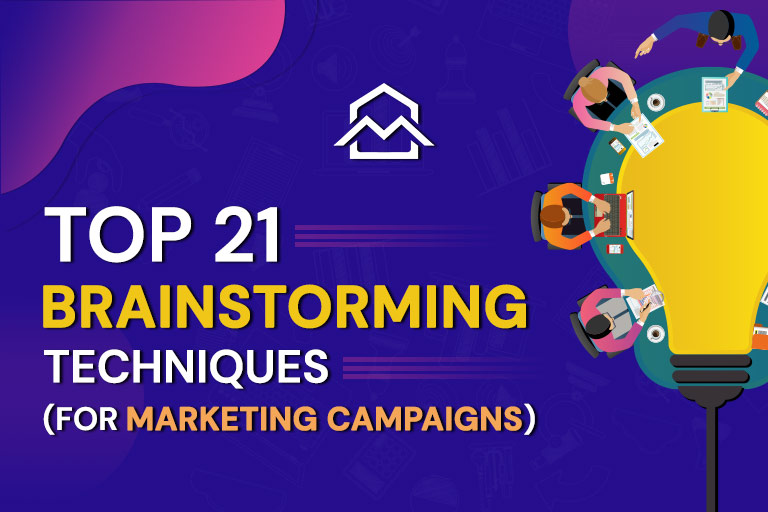
In the world of business, being innovative and creative is the key to staying ahead of your competition. At House of Marketers, we know a thing or two about creative ideas because we spend the majority part of our days helping our clients turn their business from “just another one” into “the talk to TikTok”.
Our secret? Constant brainstorming, smart strategizing, and clever problem-solving to create killer marketing campaigns that truly convert, connect and captivate.
So, ready to up your marketing game? We’re sharing our top 21 brainstorming techniques, trusted by us and marketing whizzes worldwide. These aren’t just your everyday idea generators – they’re the tools we use to ignite creativity, improve teamwork, and solve problems.
Whether you’re mapping out a new TikTok campaign, prepping for a product launch, or hunting for unique ways to engage your audience, these techniques would be the spark to light up your next viral hit.
“At its heart, marketing is about creativity and coming up with new ideas. And if you’re struggling to get into the right creative headspace, then it’s time to get the whole team involved.”
We’ll break down each technique, explain how to implement it, and offer insights on when best to use it. By the end of this article, you’ll have a robust toolkit of brainstorming strategies to elevate your marketing campaigns.
To know more about how we can collaborate with you for your custom tiktok strategy.
Understanding Brainstorming
Brainstorming is a group creativity technique that involves using technical tactics to find a positive conclusion to a specific problem.
In simple terms, it’s a strategy used to solve problems by allowing members of a team to contribute their ideas in an open meeting.
But how do you brainstorm effectively? Where do you even start?
At its heart, marketing is about creativity and coming up with new ideas. And if you’re struggling to get into the right creative headspace, it may just be time to get the whole team involved.
“We encourage our employees, in addition to their regular projects, to spend 20% of their time working on what they think will most benefit Google,” said Google founders Sergey Brin and Larry Page
The power of brainstorming lies in its ability to harness diverse perspectives, encourage free thinking, and reduce inhibitions around suggesting ideas.
There are many benefits to involving the whole team in a brainstorming session as shown below.
- A different set of eyes on a challenge helps you gain a new perspective.
- You discover some creative team members, who might not have voiced their ideas if left alone.
- Brainstorming sessions can be fun and provide a much-needed morale booster for struggling marketing teams.
- Brainstorming can also boost team cohesion.
Did you know that the founders of Google grew their business by making every employee dedicate 20% of their time to creativity and innovation? That’s how Google has become the powerhouse it is today!
Setting up for Successful Brainstorming
Now that we understand what brainstorming is, let’s discuss how to set up an environment conducive to it. Effective brainstorming is not just about assembling a group of people in a room and expecting creative ideas to flow. It requires careful planning and the right environment.
“Without a defined problem or goal, the brainstorming session can quickly become unproductive.”
If you give people a chance to research in advance, they are more likely to come up with high-quality ideas. There is no point in brainstorming about a topic that nobody knows anything about. For example, you won’t gain much by asking someone who doesn’t know anything about NFTs, to come up with marketing ideas for an NFT exchange platform. One useful strategy could be to look at relevant industry data or influencer statistics before the brainstorming session.
Another piece of advice we can offer is to do some research beforehand and brief the team on some key pieces of information for an effective brainstorming session.
The information that you should be offering to everyone involved includes:
- Who is your audience?
- What do they care about?
- What do they like/dislike?
- What are their interests and passions?
These questions help provide your team with some context into what the goals of the strategy session are leading to a better marketing strategy.
Now, let’s move on to the 21 brainstorming techniques you could use to come up with ideas.

The 21 Brainstorming Techniques
These techniques vary in their approach, offering a mix of structured and free-flowing methods to cater to different situations and team dynamics.
Remember, there is no one-size-fits-all solution in brainstorming. The technique you choose should depend on your specific goals, the team you’re working with, and the nature of the problem at hand.
1. Free Flow of Ideas with “Mind Mapping”
Mind Mapping is a visual brainstorming tool that encourages the free flow of ideas stemming from a single central concept. Think of it as a tree with branches, where each branch represents a connected idea or topic.
Start with a central concept, like “TikTok Campaign,” then branch out into related topics (content, influencers, engagement) and keep branching out with more specific ideas.
This method can help visualise the full scope of a campaign and generate new ideas.
Technique in Action
Suppose you are tasked with developing a marketing strategy for a fitness brand’s TikTok channel.
Start with a central concept like “Fitness Brand TikTok Strategy. Draw branches that represent key strategy components, such as:
- Content Types
- Engagement Tactics
- Partnership Opportunities
- Posting Schedule
Each of these branches will further branch into more specific ideas. For instance, under “Content Types,” you could list ideas like:
- Workout Tutorials
- Nutrition Tips
- Transformation Stories
- and so on.
This visual representation will help you organise your thoughts and identify connections between different ideas, ultimately leading to a comprehensive marketing strategy.
Best Usage: Mind Mapping is best used when you are starting with a broad concept and need to break it down into smaller, more manageable components.
It is also excellent for times when you want to explore how different ideas might be connected.
2. Challenge the Norms with “SWOT Analysis”
SWOT Analysis (Strengths, Weaknesses, Opportunities, Threats) is a strategic planning tool used to help a person or organisation identify key internal and external factors that may influence their goals.
Technique in Action
Conduct a SWOT analysis on your current TikTok strategy to identify areas of success, potential improvements, and external factors that could impact your campaign.
This analysis can provide valuable insights that help shape more effective TikTok marketing strategies.
- Strengths: Identify what your brand excels at. Perhaps you have a charismatic spokesperson who’s great on camera, or you already have high brand recognition among TikTok users.
- Weaknesses: Acknowledge areas that need improvement. Maybe you lack experience in short-form video content or don’t fully understand TikTok trends.
- Opportunities: Look for untapped potential. There could be a trending dance that aligns with your fitness brand, or a popular fitness challenge you could participate in.
- Threats: Recognize potential obstacles. These could be competitors with a strong TikTok presence or shifts in TikTok’s algorithm that affect content visibility.
Best Usage: SWOT Analysis is best used when you need a clear understanding of your current situation before planning a campaign. It helps uncover opportunities you can leverage and threats you should be prepared for.

3. The Six Thinking Hats
The Six Thinking Hats, developed by Edward de Bono, is a method that encourages participants to think from different perspectives.
Each “hat” represents a certain type of thinking: White (facts), Red (emotions), Black (caution), Yellow (benefits), Green (creativity), and Blue (process).
Technique in Action
Gather your team and assign each member a different “hat.”
- The person wearing the “Green Hat” (creativity) might suggest engaging in trending TikTok challenges or creating unique hashtag challenges.
- The “Red Hat” wearer (emotion) could provide insight into how viewers might react to your videos emotionally.
- The “Black Hat” (caution) can identify potential pitfalls or negative viewer reactions to avoid.
Best Usage: This technique works best in group settings where diverse perspectives are necessary. It’s particularly useful when you want to ensure all angles are considered before deciding on a strategy.
4. Plan with “Star bursting”
Starbursting focuses on questioning rather than directly seeking answers. It helps teams consider an idea from multiple perspectives. It starts with a central question about the issue at hand, from which participants generate as many related questions as possible.
Technique in Action
Start with a central question like “How can we increase our followers on TikTok?”
Then, team members can generate related questions such as:
“What types of content are currently trending on TikTok?”
“What demographics are we trying to reach?”
“What has worked well for our competitors?”
“Can we collaborate with TikTok influencers to broaden our reach?”
These questions can guide your research and strategy development process.
Best Usage: Starbursting is best used in the early stages of campaign planning when you’re trying to understand all aspects of a problem or situation.
5. Free Your Mind with “Rapid Ideation”
Rapid Ideation involves generating as many ideas as possible within a set timeframe. The focus is on quantity rather than quality – a higher volume of ideas increases the chances of finding unique ideas.
Technique in Action
To get started, set a timer for a specific period (e.g., 15 minutes) and ask your team to generate as many ideas for TikTok content as they can.
Ideas might range from starting a unique brand hashtag challenge to creating behind-the-scenes videos to hosting live Q&A sessions.
Once the timer stops, discuss and review the ideas to identify any that stand out or could be developed further.
Best Usage: Rapid Ideation is particularly useful when you feel stuck or need a large number of ideas quickly. It’s also great for encouraging free thinking and innovation.
6. Unleash Collective Creativity with “Group Brainstorming”
In Group Brainstorming, everyone in a group shares their ideas in a non-judgmental environment. Participants take turns sharing an idea, ensuring everyone contributes equally.
Technique in Action
Gather your team and explain the objective (e.g.,” We need ideas for a new TikTok series promoting our products”).
Each team member then shares one idea in turn, fostering a fair and inclusive environment. Remember, the aim is quantity over quality at this stage – the more ideas generated, the more material to refine and develop later.
This method might uncover ideas that may not surface in a traditional free-for-all discussion.
Best Usage: Group Brainstorming is best used when you want to ensure equal participation, especially in groups where some members might otherwise dominate the conversation.

7. Storyboard Your Success with “Storyboarding”
Storyboarding involves visually telling your story, step by step. It’s a powerful way to visualise the journey you want your audience to take.
Technique in action
Lay out a storyboard for a series of TikTok videos, each frame representing a different video.
Illustrate the content of each video, potential reactions, and the next steps for the audience (like sharing, liking, or commenting).
This visual narrative will help your team understand the customer journey better and make adjustments as needed.
Best Usage: Use storyboarding when you’re planning a sequence of events or messages, like a TikTok video series or a multi-part marketing campaign.
8. Change your Perspective with the “SCAMPER Method”
The SCAMPER Method is an acronym for Substitute, Combine, Adapt, Modify, Put to another use, Eliminate, and Reverse. It’s a brainstorming tool that pushes you to think about a product, service, or process in a new way, sparking innovative ideas by questioning the existing order of things.
Technique in action
Utilise the SCAMPER elements by asking relevant questions tailored to your TikTok strategy. For instance:
- Substitute: “What elements can we substitute in our current content to make it more engaging or relevant to our audience?”
- Combine: “Can we combine different content types or themes to create something unique and interesting for our viewers?”
- Adapt: “What trends are popular on TikTok now and how can we adapt them to align with our brand and engage our audience?”
- Modify: “What modifications can we make to our content style, format, or presentation to differentiate ourselves from competitors?”
- Put to another use: “Are there content ideas from other platforms that we can creatively repurpose for TikTok?”
- Eliminate: “Are there elements in our current content that are not resonating with our audience and should be removed?”
- Reverse: “Can we reverse or rearrange some aspects of our content to bring a fresh perspective or surprise our audience?”
This method encourages you to view your content from various angles, helping unearth creative twists to your TikTok strategies.
Best Usage: The SCAMPER Method is best used when you’re trying to enhance or refresh existing ideas, strategies, or products. It’s particularly useful when you want to refresh your content strategy.
9. Step into Someone Else’s shoes with “Role Storming”
Role Storming involves brainstorming ideas from the perspective of someone else. This shift in viewpoint can lead to novel ideas that may not emerge from your regular thinking patterns.
Technique in Action
During brainstorming sessions, team members can assume roles like a Gen Z TikTok user, a top-tier influencer, a competitor’s social media strategist, or even a sceptic of your product or service.
From these personas’ perspectives, generate ideas about the type of content they would find appealing, the strategies that might outshine the competition or the pain points they might have that your product can solve.
For instance, if you’re role-playing as a Gen Z TikTok user, consider the latest trends they’re following, the influencers they adore, or the social causes they care about.
If you’re stepping into a competitor’s shoes, think about what strategies they’re using that are working well and how you could do it better or differently to gain a competitive edge.
This approach can provide fresh, user-centric insights into your audience’s preferences and effective competitor strategies that you can incorporate into your TikTok marketing.
Best Usage: Role Storming is particularly useful when you want to step outside of your normal thinking patterns and consider unique perspectives.

10. Uncover Hidden Insights with the “Five Whys”
The Five Whys involves asking “Why?” five times to get to the root of a problem or situation. Each response forms the foundation of the next question, helping to get to the root cause of an issue.
Technique in action
Let’s say you’re facing a challenge where engagement on your TikTok posts is falling short. Start by asking, “Why is our TikTok engagement low?”
The answer could be, “Our content isn’t resonating with our audience.”
This leads to the next question: “Why isn’t our content resonating?” The answer might be, “Our content doesn’t reflect current TikTok trends.” The line of inquiry continues until you’ve unearthed a core issue that can be addressed in your strategy.
The Five Whys method helps peel back the layers of symptoms to reveal the underlying problem, allowing you to craft a more targeted and effective TikTok marketing strategy.
Best Usage: The Five Whys technique is best used when facing a problem or challenge that needs to be understood more deeply, especially to uncover underlying issues.
11. Flip the Script with “Reverse Brainstorming”
Reverse Brainstorming, or Negative Brainstorming, flips a question on its head. Instead of asking, “How do I solve this problem?” you ask, “How could I possibly cause the problem?”
Technique in action
Suppose your challenge is to boost your follower count on TikTok. With Reverse Brainstorming, you’d instead ask, “How could we lose followers on TikTok?”
Answers might include inconsistent posting schedules, content that doesn’t engage or entertain, not responding to user comments, or failing to participate in trending challenges or hashtag movements.
By identifying these potential pitfalls, you gain valuable insights into what not to do, helping you formulate a more effective and engaging TikTok strategy.
Best Usage: Reverse Brainstorming is a fantastic tool when traditional brainstorming isn’t generating the results you want, or when you’re looking to challenge assumptions and stimulate unconventional thinking. It’s also a great technique for identifying potential problems before they occur, allowing for preemptive solutions.
12. Take the Stage with “Role Play”
Role Play is a popular and interactive brainstorming technique, encouraging participants to act out scenarios. This can spur creative ideas, help better understand a problem, or test potential solutions in a realistic yet controlled setting.
Technique in Action
During brainstorming sessions, team members can take on roles of different TikTok user personas, such as fashion enthusiasts, DIY lovers, fitness buffs, or foodies. They then interact with your proposed content, reacting as they believe their persona would.
This could involve acting out how they’d respond to a tutorial, the excitement they might feel for a product unboxing or the engagement they’d have with a trending challenge related to your brand.
The reactions, comments, and discussions arising from these role plays can offer valuable insights into how different types of users might perceive and interact with your TikTok content.
Best Usage: Role Play can be a powerful technique when trying to understand user behaviours, preferences, and reactions more realistically and dynamically.
13. Unleash Your Creativity with the “Madman Method”
The Madman Method involves unleashing your wildest, most out-of-the-box ideas without any inhibition. This method is all about fostering a safe space for radical creativity and unbounded imagination.
Technique in action
During brainstorming, urge team members to unleash the most outrageous, left-field TikTok marketing strategies they can come up with. Encourage boldness and novelty over practicality in this stage.
Examples might include planning and starting a challenge with an absurdly funny or catchy dance or creating a series of TikToks from the perspective of an office pet.
While these ideas may initially seem “mad,” they often can be scaled back or adapted into innovative, feasible strategies.
Best Usage: The Madman Method is particularly useful during brainstorming sessions that seem to be stuck in conventional thinking or when the team needs a creativity boost.

14. Connect the Dots with “Analogous Inspiration”
Analogous Inspiration involves looking at how different industries or companies solve similar problems and applying those solutions to your situation. This technique lets you and your team harness proven strategies and adapt them creatively to your unique circumstances.
Technique in action
Research successful marketing campaigns outside of your industry and brainstorm how their tactics can be applied to your brand.
For example, how did a food brand effectively use humour in its Instagram videos? Could a similar approach work for your brand?
Best Usage: This technique is excellent when looking for innovative solutions that have already been successful in different contexts.
15. Write it Down with “Brainwriting”
Brainwriting is similar to brainstorming but instead of speaking ideas aloud, participants write them down. This technique ensures everyone gets a chance to contribute without interruption, balancing the playing field for both vocal and quiet team members.
Technique in action
Brainwriting is a quiet alternative to brainstorming. It works best in teams where there are a lot of dominant personalities who may take over the conversation.
During a brainwriting session, one person writes down their ideas on a piece of paper and then passes it to the person next to them. The recipient must read each idea silently followed by building and improving upon the ideas on the paper. The process continues until everyone has added an idea and passed the paper along.
It’s a method that can reduce social conforming, which can come into play during a brainstorming session with multiple people.
Best Usage: Brainwriting is a good method to use when your team is large or when some individuals tend to dominate verbal brainstorming sessions.
16. Step Up the Game with “Gamified Brainstorming”
Gamified Brainstorming involves turning the brainstorming process into a game with rules, points, and a competitive element.
Technique in action
Create a game in which points are awarded for aspects like the originality of the idea, relevance to the brand, potential virality on TikTok, engagement potential, or alignment with current trends.
For example, an idea might score points based on how well it fits with a trending hashtag, its potential to attract user-generated content or the likelihood of it being shared by followers.
This method can motivate team members to think more creatively, as they strive to earn points, and can make the brainstorming process more enjoyable, promoting active participation.
Best Usage: This is a great method when you need to inject some fun into the brainstorming process or when team engagement levels are low.

17. Change Your Perspective with the “Charette Procedure”
The Charette Procedure is a useful technique for teams that are larger in number or diverse in roles and functions. You optimise the brainstorming sessions by dividing a large group into smaller teams. Each team begins brainstorming on a topic, then passes their work to the next group to build upon, and so on.
Technique in action
Start by dividing your team into smaller groups. Assign each group a different aspect of the TikTok campaign. This could include content creation, engagement strategies, influencer partnerships, hashtag challenges, etc.
After a set period of brainstorming, rotate the topics among the groups. Each group will review and build on the previous group’s ideas, bringing a fresh perspective and enhancing the ideas with their unique insights.
This style of brainstorming ensures that every aspect of the campaign is viewed from various angles, leading to well-rounded and innovative strategies.
Best Usage: This technique is excellent for large groups and ensures that every voice is heard and maximises the creative potential of your team.
18. Think in Tandem with “Paired Comparison Analysis”
Paired Comparison Analysis is a method for prioritising a small number of work-related ideas. Each idea is compared against all others one-on-one to determine which carries the most value or importance. This method helps to identify the ideas with the highest potential impact.
Technique in action
After brainstorming content ideas for TikTok, list them and compare each idea with the others one-on-one.
Each comparison should be discussed and scored based on criteria like potential impact, feasibility, and alignment with brand identity.
This allows you to systematically determine which ideas hold the most potential.
Best Usage: This technique is best used when you have a variety of good ideas and need to determine which are worth pursuing.
19. Visualise Ideas with the “Lotus Blossom Technique”
The Lotus Blossom Technique uses a visual diagram to explore all possible facets of an idea or problem. Beginning with a central theme, you identify eight related sub-themes or components, each of which becomes the centre of a new ‘lotus blossom’ of ideas. This process allows for an extensive and detailed exploration of your initial idea or problem.
Technique in action
For instance, if your central idea is “Promoting our new product on TikTok”, draw eight boxes around this centre for related sub-themes. These could be product demonstrations, customer testimonials, influencer partnerships, behind-the-scenes footage, user-generated content, etc. Each of these sub-themes would then form the centre of its lotus blossom.
Each of these sub-themes then forms the centre of its lotus blossom, with another eight boxes drawn around it for further related ideas. For example, “product demonstrations” could branch out to ideas like “how-to guides”, “before-and-after comparisons”, “product unboxing”, and so forth.
This iterative method allows for a comprehensive exploration of various content possibilities for your marketing campaign, ensuring no potential idea is left unexplored.
Best Usage: The Lotus Blossom Technique is excellent for delving deep into a concept or problem, allowing you to explore all its facets in depth.

20. Rapid Fire Ideas with “Speed Storming”
Speed Storming combines brainstorming with speed dating. Speed Storming is an energetic brainstorming technique that blends the concept of speed dating with traditional brainstorming. Participants rotate through brief one-on-one meetings, allowing for a quick and diverse exchange of ideas.
Technique in action
Each participant can share their best TikTok content idea in a quick one-on-one meeting before moving to the next person.
This method allows for a rapid exchange of ideas and encourages participants to think on their feet.
Best Usage: Speed Storming is a great technique for energising your team and encouraging the sharing of a diverse range of ideas in a short amount of time.
21. Problem Solve with “Design Thinking”
Design Thinking is a methodology used by designers to solve complex problems and find desirable solutions. It is a solution-focused and action-oriented way of creating innovative ideas, where the main strategy is to empathise with and understand the user.
Technique in Action
- Empathise – Start by understanding your TikTok audience. Use methods such as surveys, interviews, or user testing to identify their needs, preferences, and challenges. In essence, put yourself in the shoes of your TikTok followers.
- Define – Identify the problem or challenge based on your understanding of the audience.
- Ideate – Brainstorm a range of content ideas that address the defined problem.
- Prototype – Create basic versions of your ideas, such as content outlines, storyboards, or short demo videos.
- Test – Gather feedback on your prototypes from a subset of your audience or team members.
- Implement – Execute the best ideas based on feedback and observation. Continually test and refine your content for the best results.
Best Usage: Design Thinking is especially useful when you’re trying to solve complex marketing problems where the user’s perspective is crucial. It’s particularly effective when you want to innovate and differentiate your brand or product in the market.
Best Practices for Effective Brainstorming Sessions
Brainstorming can be a powerful tool for generating innovative marketing ideas, but its effectiveness is largely determined by how it’s conducted.
To know more about how we can collaborate with you for your custom tiktok strategy.
Here are some best practices to make the most out of your brainstorming sessions:
- Set Clear Objectives: Clearly define what you want to achieve from the brainstorming session.
- Create a Safe Space: Encourage free thinking and ensure all participants feel comfortable sharing their ideas, no matter how outlandish.
- Encourage Diverse Opinions: Invite people from different backgrounds and departments.
- Value Quantity over Quality: The goal of a brainstorming session is to generate as many ideas as possible.
- Keep an Open Mind: Encourage participants to think outside the box and challenge the status quo.
- Document Everything: Make sure to record all ideas, even the ones that seem less feasible.
- Build on Ideas: Encourage participants to listen to each other’s ideas and build upon them.
- Follow Up: After the brainstorming session, categorise and evaluate the ideas. Shortlist the most promising ones for further research and testing. An idea is only as good as its execution, so ensure you take actionable steps to implement these ideas.
Marketing always involves experimentation and failure, but if you don’t try then you won’t succeed! As Drew Houstan, Dropbox Co-founder, and CEO once said, “Don’t worry about failure; you only have to be right once.”
Key Takeaways
Brainstorming can be an inspiring and productive process, acting as the ignition spark that lights the way to your next breakthrough TikTok marketing campaign.
Remember, the effectiveness of these techniques can often depend on the unique dynamics of your team and the specific challenges you face. Feel free to mix and match, tweak, and personalise them to suit your needs.
As you start implementing these techniques, don’t shy away from those wild ideas. Sometimes, they pave the way for the most groundbreaking and engaging TikTok campaigns.
We hope these techniques inspire you and your team to brainstorm better, think bigger, and unlock the full potential of your TikTok marketing campaigns. Happy brainstorming!
Interested in launching a powerful TikTok marketing campaign? Want to leave the brainstorming techniques and campaign execution to our team? To learn more about how we can take your upcoming campaign to the next level, get in touch with our expert team today.

House of Marketers (HOM) is a leading TikTok Marketing Agency. Our global agency was built by early TikTok Employees & TikTok Partners, which gives us the insider knowledge to help leading brands, like Redbull, Playtika, Badoo, and HelloFresh win on TikTok. Want us to convert more of Gen Z and Millennials with TikTok? Get in touch with our friendly team, here.